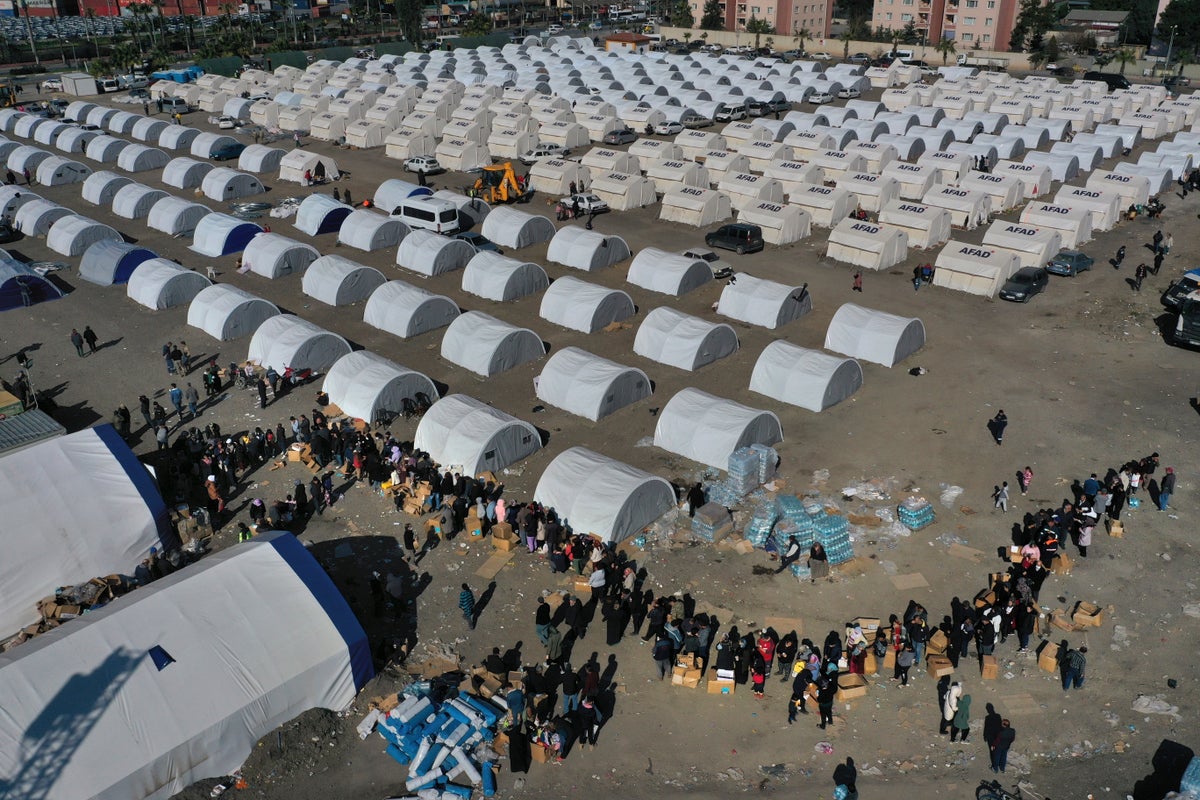
Nearly two weeks after a massive earthquake leveled tens of thousands of buildings and displaced millions of people in Turkey and Syria, many are still struggling to fulfill their basic needs and some are bedding down in tents, factories, train cars and greenhouses.
People pushed from their homes in the disaster zone described a wide range of conditions: Some were able to find regular hot showers, while others feared freezing to death.
The Turkish government and dozens of aid groups have launched a massive relief effort. The government said Wednesday that more than 5,400 shipping containers have been deployed as shelters and over 200,000 tents dispatched.
But it’s facing a massive disaster. The government says at least 56,000 buildings, containing more than 225,000 homes, were either destroyed by the Feb. 6 quake or too damaged to be used. There is no official figure for the number of people displaced in Turkey’s side of the disaster region, which is home to some 14 million, or 16% of the country's population.
In the mountain villages of Kahramanmaras province, locals battle to keep warm during the bitterly cold nights.
Buyuknacar, a village just a few kilometers (miles) from the epicenter of the 7.8 magnitude quake, was severely damaged and 158 were killed. Two days after the initial tremor, a military helicopter brought supplies and on the fifth day the road was cleared.
Although the villagers have tents, they are too flimsy to keep out the cold. Villagers said they feared icy conditions in the mountains would lead to further deaths.
Umut Sitil, 45, said: “Our basic need is, first, containers. Tents won’t work here. ... People in tents will freeze to death.”
On Tuesday, President Recep Tayyip Erdogan said 2.2 million people had left the disaster zone. Of those, he said, the housing needs of 1.6 million had been fulfilled, including some 890,000 people placed in public facilities, such as student dormitories, and 50,000 in hotels.
The Transport Ministry said Wednesday that the government had helped more than 272,000 to evacuate by air, sea and rail. However, many people prefer to remain close to their homes, either to protect their possessions, wait for relatives' bodies to be recovered or, in rural areas, care for their livestock.
Others seeking protection from winter temperatures have resorted to any structure that will keep out the elements.
Near the Mediterranean coast in Hatay, one of the hardest-hit provinces, farmers in Samandag district fled their damaged homes to large tunnel-style greenhouses used for growing tomatoes, bringing with them whatever bedding and cooking utensils they could salvage.
Locals said that around 2,000 people were now living under the plastic covers. Many had lost not just their homes but also their livestock.
“There’s no safe place apart from the greenhouses, because the houses collapsed due to the earthquake,” said Ozkan Sagaltici, in his 50s.
The villagers have set up wood stoves inside the greenhouses to cook the food handed out by aid agencies.
“We have no clean clothes,” said Suzan Sagaltici, who's staying in a greenhouse on the other side of the village. “We can’t clean ourselves as we would like to, we can’t take a shower. It’s very difficult to live here. There’s no sink. We have nothing. It’s like living in the open air.”
Other displaced people have found relatively stable shelter. Elsewhere in Hatay, the Yuksel family found refuge in a metal factory, where they have been provided with necessities including clothing and household items.
Veysel Yuksel, his wife, Dilek Nur Yuksel, and their three children are living in a trailer at the factory near the port city of Iskenderun. The children play among heavy machinery as their parents prepare food.
“Our house has not been completely destroyed but seriously damaged,” said Yuksel. “All the buildings surrounding ours have been ruined."
In the first days after the earthquake, around 1,600 people from the nearby town of Dortyol stayed at the factory, but half later left for other parts of Turkey.
The displaced residents can use a shared bathroom with hot water, a laundry and a small kitchen. They sleep in offices, shipping containers or trailers.
At Iskenderun’s rail station, families shelter in train carriages, according to the state-run Andalou Agency.
“Our house has become unusable, we can’t get into it,” said Nida Karahan, 50, whose family of five was living in a cream- and red-painted carriage. “The wagons have become our home.”
As well as providing warm shelter, people said they were being provided with three meals a day by the military.
Qatar is sending shelters used to house soccer fans during last year’s World Cup. Many other nations have also sent tents and containers.
In the provincial capital of Kahramanmaras, which has the same name as the province, residents also complained of difficulties finding a place to stay.
“I couldn’t find anything like a tent for the first three or four days,” said father-of-three Haci Kose. “I went around with my family in my car (but) couldn’t find a place to stay wherever I went. They said there are tents here and there (but) they’re making it up.”
He was eventually allocated a tent by an Azerbaijani aid agency, but said he still has problems getting enough to eat or finding a place to relieve himself.
“I wish we were stuck under the rubble too so we didn’t have to live in this situation,” Kose added. “The aid isn’t coming to the people in the tents.”







